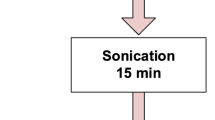Abstract
In this study, experiments and theoretical analyses were performed on the partial discharge initiation voltage of the electrode–bound void according to various electrode materials, including the semi-conductive rubber in the joint box of the high voltage power cable. Electrode–bound void specimens using Brass, Al, Cu, SUS and EPDM semiconducting rubber were prepared, and PDIV (partial discharge inception voltage) was measured and analyzed at 25, 60 and 90 °C. As a result, it was found that the PDIV of the electrode–bound void is dependent on the work function of the electrode. It was possible to interpret the measurement results through the calculation of the discharge voltage using Paschen’s law in combination with the thermionic emission of the electrode and thermal expansion of materials. In addition, in the case of the EPDM semiconducting rubber electrode, it was analyzed that the measured PDIV was lower than the calculated value because the void thickness was reduced due to elasticity.











Similar content being viewed by others
References
Kruger FH (1989) Partial Discharge Detection in High-Voltage Equipment. Butterworths, Oxford
Lutz N (1995) A generalized approach to partial discharge modeling. IEEE Trans Dielectr Electr Insul 2(4):510–528
IEC 60840 (2011) Power cables with extruded insulation and their accessories for rated voltages above 30 kV (Um = 36 kV) up to 150 kV (Um = 170 kV) – test methods and requirements, Edition 4.0
IEC 62271-201(2014) High-voltage swithchgear and controlgear – part 201: AC solid-insulation enclosed switchgear and controlgear for rated voltages above 1 kV and up to and including 52 kV, Edition 2.0
Lide DR (2009) Handbook of chemistry and physics, 90th edn. CRC Press Inc., Relié
Pellegrini B (1976) Properties of silicon-metal contacts versus metal work-function silicon impurity concentration and bias voltage. J Phys D Appl Phys 9:55–68
Wetz D(2006) The impact of water conductivity, electrode material, and electrode surface roughness on the pulsed breakdown strength of water. In: 27th International power modulator symposium, pp 104–107
Sominski GG (1999) Field emitters with carbon containing coverages and based on carbon fibers: possibilities of creation and use in microwave electronics. In: Electronics and radiophysics of ultra-high frequencies (Cat No 99EX356), pp 327–330
Hepburn DM, Kenip J, Richardson RT, Shields AJ (1995) Role of electrode material in partial discharge chemistry. In: IEEE 5th international conference on conduction and breakdown in solid dielectrics, pp 605–610
Jonggi Hong S, Choi M-S, Won, Kang H (2015) A study of the dielectric characteristics of gaseous nitrogen with respect to the electrode material for develo** a high voltage superconducting fault current limiter. IEEE Trans Appl Superconduct 25(3):8800504
Yun Jiang H, Min J, Luo Yu, Li H, Li X, Jiang R, **a W, Li (2010) Partial discharge pattern characteristic of MV cable joints with artificial defect. In: CICED 2010 Proceedings
Song X, **a Y, Jia Z, Li Y, Wang X (2018) Typical defect simulation of 110 kV cable and its partial discharge characteristic test. In: 12th IEEE international conference on the properties and applications of dielectric materials, **’an China, pp 764–767
Husain E, Nema RS (1982) Analysis of Paschen curves for air, N2 and SF6 using the Townsend Breakdown equation. IEEE Trans Electr Insul Vol EI–17(4):350–353
Liebermann MA (2005) Principles of plasma discharge and materials processing. Wiley, New York, pp 302–303
Kantar E, Mauseth F, Ildstad E, Hvidsten S (2017) On the tangential AC breakdown strength of polymer interfaces considering elastic modulus. In: IEEE conference on electrical insulation and dielectric phenomenon (CEIDP), Texas
Yu L (December 2015) Silicone rubbers for dielectric elastomers with improved dielectric and mechanical properties as a result of substituting silica with titanium dioxide. Int J Smart Nano Mater 6(4):1–22
Long SHI, Yit Lin M (2013) “A review of fire processes modeling of combustible materials under external heat flux”. Fuel 106:30–50. https://doi.org/10.1016/j.fuel.2012.12.057
Jae-Han K (2019) Thermal expansion behavior of thin films expanding freely on water surface. Sci Rep 9:7071. https://doi.org/10.1038/s41598-019-43592-x
https://en.wikipedia.org/wiki/Ideal_gas_law# Combined_gas_law
Mokhothu TH, Luyt AS, Messori M (2014) Preparation and characterization of EPDM/silica composites prepared through non hydrolytic sol-gel in the absence and presence of a coupling agent. Express Polym Lett. https://doi.org/10.3144/expresspolymlett.2014.83
Jung Keun C et al (2020) Heat dissipative mechanical dam** properties of EPDM rubber composites including hybrid fillers of aluminium nitride and boron nitride. Soft Matter 16:6812–6818
Author information
Authors and Affiliations
Corresponding author
Additional information
Publisher’s Note
Springer Nature remains neutral with regard to jurisdictional claims in published maps and institutional affiliations.
Rights and permissions
Springer Nature or its licensor (e.g. a society or other partner) holds exclusive rights to this article under a publishing agreement with the author(s) or other rightsholder(s); author self-archiving of the accepted manuscript version of this article is solely governed by the terms of such publishing agreement and applicable law.
About this article
Cite this article
Yoon, S., Son, H., Kim, J. et al. Characteristics of Partial Discharge Inception Voltage for Electrode-Bound Voids According to Electrode Materials. J. Electr. Eng. Technol. 18, 3083–3090 (2023). https://doi.org/10.1007/s42835-022-01361-3
Received:
Revised:
Accepted:
Published:
Issue Date:
DOI: https://doi.org/10.1007/s42835-022-01361-3




